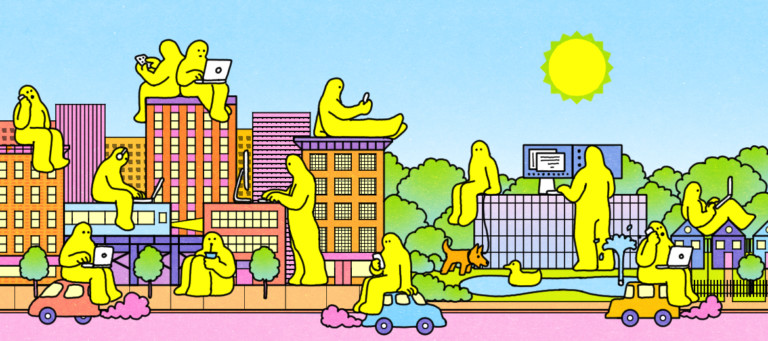
The war for talent has some companies abandoning their sprawling campuses for hipper city centers, but as millennials age into their 30s, will a modern suburban workplace hold more appeal?
by Sarah Fister Gale
April 30, 2018
When families flocked to the suburbs in the 60s and 70s, companies were quick to follow. If they wanted to attract and retain young professionals of that era, they needed move out of the city and build new space that provided workers with a shorter commute, free parking and more space. This trend led to a surge in suburban office park construction, and for decades business leaders reveled in the chance to spread their footprint over relatively cheap and open land. Soon, suburban America was dotted with corporate campuses made up almost entirely of multistory concrete cubicle farms surrounded by vast parking lots.
Fast-forward 50 years and the tides have changed. After the recent recession finally ended, companies found themselves fighting to attract millennial talent and their younger Gen Z counterparts. But offering them their very own cube in a suburban office park didn’t have much appeal.
“Millennials work differently, and they live differently than prior generations,” said Sheryl Schulze, senior associate in Gensler’s Chicago office, an architecture, design, planning and consulting firm. This generation of workers has put off marriage, home buying and other lifestyle choices that make the suburbs appealing. They also tend to work long, odd hours and expect to be able to balance their professional and personal lives within the confines of the workplace.
That means companies and commercial developers need to think more strategically about where to locate office space and what features and amenities to include when remodeling these spaces.
To appeal to today’s worker, companies have to offer more than a fitness center in the basement, said Margie Baran, senior vice president of Midwest project and development services for JLL, a commercial real estate company based in Chicago. They expect Starbucks in the lobby, yoga classes, golf simulators, collaboration rooms, food service options and outdoor spaces all within walking distance of their shared workspace.
RELATED: How to Redesign Work After an Office Refresh
This demand for more integrated, amenity-laden spaces is forcing companies to make one of two decisions: abandon the burbs and head back to the city where all the hip, young talent want to work and play; or stay in the burbs and remodel those outdated office parks into mini urban environments with restaurants, retail and walkable living space that will cater to their needs today and in the future.
Both options come with benefits and risks, said Damla Gerhart, senior managing director for CBRE Group, a global commercial real estate services and investment firm based in Los Angeles. Moving a headquarters into a busy city can be disruptive, costly and often require extensive infrastructure remodels to make an old building fit a modern era. But companies that make this move can be much more attractive to the 20-something talent they are working so hard to recruit. That extra effort to attract young workers can make it worthwhile, she said.
On the other hand, land in the suburbs is less expensive, and because office parks tend to be newer than city structures, they have more modern HVAC and IT systems, which can reduce the need for infrastructure upgrades. However, transforming acres of office buildings into something that today’s workforce will find even remotely appealing is a huge undertaking. Though the effort may be worth it, especially for companies who own the office parks outright, Gerhart said. “These are massive assets that can be difficult to sell.”
Option 1: Back to the City
Even with the high cost of downtown office space, it’s become a popular choice for the biggest brands. Over the past few years, several major organizations announced plans to abandon their suburban campuses for nearby cities, including McDonalds, which is leaving its 74-acre Oak Brook campus after 40 years to move to Chicago’s bustling Fulton Market neighborhood. Marriot also announced plans last year to move 3,200 employees out of its sprawling suburban headquarters in Maryland to a new $600 million office complex in downtown Bethesda; and GE is making a similar move from a Connecticut suburb to downtown Boston.
One of the benefits of heading to the city is that it gives them instant access to desirable amenities, including restaurants, bars, public transportation and lots of apartment living. But it’s not enough to simply rent some office space — nor is it that easy.
In well-established cities like Chicago, Boston and New York, finding vacant offices that accommodate hundreds or even thousands of employees can be extremely challenging, which often leads to massive remodeling projects targeting decades-old buildings that were often built for totally different applications.
Transforming libraries, temples, warehouses and other outdated structures into something sleek and modern with an authentic vibe can take years and hundreds of millions of dollars. But it’s necessary, said Eric Feinberg, executive vice president of Savills Studley, a commercial real estate services firm in Chicago. “To compete for talent in these markets, you have to remodel.”
The Hidden Cost of Remodels
It all starts with the heating and cooling system, Feinberg said. “Cool retro buildings can attract young companies that want to be in interesting spaces,” he said. “But no one wants to work in a rundown building where the air conditioning doesn’t work.” New HVAC systems can cost millions of dollars, which building owners can find frustrating because they don’t deliver any visual benefits to a building. “Tenants don’t always realize how important HVAC is because they don’t see any changes,” JLL’s Baran said. “But they feel it.”
 Other remodeling challenges can be more difficult to address. For example, open-floor concepts continue to be popular requests in office design with companies opting for mobile walls and flexible furniture rather than permanent office spaces. But this design aesthetic can be tricky to achieve in something built in the early 20th century. “Many older buildings have support columns every 8 to 12 feet, which limits the ability to create open spaces,” said Mason Mularoni, research manager for JLL in Boston. These issues are less of a problem in old warehouses or lofts, which developers often take down to the studs then build back up to suit the exact needs of their tenants. But an office building from the 1920s with designated landmark status will have bigger limitations. “Tenants need to take that into consideration when they chose to remodel a landmark building.”
Other remodeling challenges can be more difficult to address. For example, open-floor concepts continue to be popular requests in office design with companies opting for mobile walls and flexible furniture rather than permanent office spaces. But this design aesthetic can be tricky to achieve in something built in the early 20th century. “Many older buildings have support columns every 8 to 12 feet, which limits the ability to create open spaces,” said Mason Mularoni, research manager for JLL in Boston. These issues are less of a problem in old warehouses or lofts, which developers often take down to the studs then build back up to suit the exact needs of their tenants. But an office building from the 1920s with designated landmark status will have bigger limitations. “Tenants need to take that into consideration when they chose to remodel a landmark building.”
Once the basics are done they can start building in the amenities. These often include brand-name food concessions and shops in the lobby, along with decks or gardens on the roof. “Rooftop decks have become a necessity, even in markets like Minneapolis and Milwaukee where the temperature makes them unusable half the time,” Baran noted. Video game rooms, gyms offering a schedule of classes and golf simulators also top the list of popular amenities. Though depending on location, some companies can rely on nearby vendors and delivery services to fill many of these gaps.
Landmark Status
Despite the challenges involved, updating an old, architecturally relevant building in a city center can be worth it. “Leveraging historical assets is very popular today,” Mularoni said. “A lot of investors and tenants take pride in properly restoring old buildings, versus building something new.”
And if the company and its new office are big enough, these remodels can have a positive impact on the entire community, he said. Consider Google’s new Midwest headquarters, a former cold-storage warehouse in Chicago’s Fulton Market neighborhood that developers transformed into a 10-story glossy glass and brick office space. Since Google opened the space in 2015, the once-quiet downtown neighborhood has attracted dozens of other businesses, along with restaurants, hotels and retail shops, making it one of the hottest areas to live and work.
Similarly, in 2013, the online shoe company Zappos remodeled an old City Hall building in a run-down area of downtown Las Vegas. The company also invested in building a park, funding real estate projects and supporting small businesses in the neighborhood to help gentrify the area. Those efforts have helped attract new businesses and shops to the area.
It shows the impact that a major urban headquarters can have on a city, Gerhart said. “These projects can bring neighborhoods back to life.” They can also be a boon for smaller firms looking for city office space with instant access to retail, restaurants and public transportation — all attractive features for today’s workers.
Option 2: A New Life for Old Office Parks
Despite the appeal of big-city living, not every business is ready to abandon its suburban roots. While the exodus out of the burbs has been consistent over the past 10 years, companies with long leases or those who own massive suburban assets often can’t afford to cut and run.
And it may not be the right choice. Gerhart noted that these office parks can still be more affordable for tenants, and they offer employees access to starter homes with big back yards and good schools, which they will inevitably want as they age out of their 20-something lifestyles. But to appeal to the modern millennial, these park owners need to do a lot more than just put a coffee shop in the lobby, she said. “We’ve seen a lot projects to turn these suburban buildings into mini-cities that replicate an urban feel in the suburbs.”
For example, developers spent three years and $35 million updating Motorola’s old and largely vacant campus in Schaumburg, Illinois, adding new and updated offices, along with restaurants, retail, a fitness center, jogging trail and other amenities that attract workers as well the general community. The once-isolated park — which residents were forbidden from entering — has become a community destination and attracted several new corporate tenants. “They are trying to create a center where people have a variety of day and night activities without having to drive anywhere,” Gensler’s Schulze said.
While suburban office vacancies are still higher than city rates, most developers expect the pendulum to continue to swing back toward the burbs as city rents rise and development efforts make these outdated office parks more appealing.
But to succeed, these transformation projects must have a vision, Schulze said. “They have to look at these properties as destinations and rethink every inch of the real estate, inside and out, to make it a place that people really want to be.”
Sarah Fister Gale is a writer in Chicago. To comment, email editor@talenteconomy.io.
Illustrations are by Ian Mackay, a visual designer based in San Francisco.




